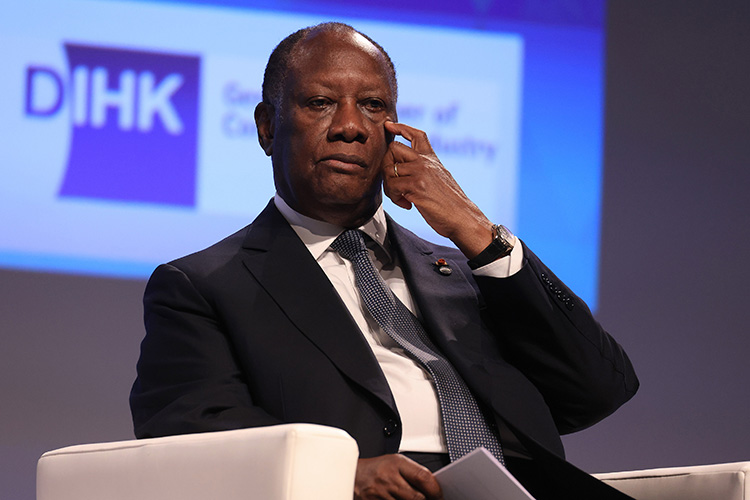Analyses / Africa/s
9 October 2025
The Ivorian Economy under Alassane Ouattara: Macroeconomic Success amid Persistent Social Challenges

Over the course of Alassane Ouattara’s three presidential terms, Côte d’Ivoire has experienced sustained economic growth, bringing stability to the country, major investments in infrastructure, and a gradual diversification of its activities. While the macroeconomic indicators reflect a solid trajectory and sound fiscal management, the benefits of this expansion remain unevenly distributed. Rural poverty, widespread underemployment, dependence on raw materials, and regional disparities continue to hinder the promise of truly inclusive and sustainable prosperity. As the presidential elections approach, beginning on 25 October 2025, Émilie Laffiteau, macroeconomist and Associate Research Fellow at IRIS, reviews the past fourteen years.
How can the economic record of Alassane Ouattara’s terms be characterised?
During Alassane Ouattara’s three terms, Côte d’Ivoire has experienced sustained and relatively stable economic growth. Between 2012 and 2024, real GDP grew by an average of 6 to 7 per cent per year, placing the country above the sub-Saharan average. This dynamic has been driven by the gradual diversification of the economy: cash-crop agriculture (cocoa, cashew nuts, rubber) remains essential, but the extractive industries (gold and hydrocarbons, including the Baleine field), agro-industry, telecommunications, construction, and financial services have gained in importance. Large infrastructure programmes (bridges, roads, ports, energy projects, stadiums, the Abidjan metro) have reinforced this trend, helping to position the country as the economic locomotive of the West African Economic and Monetary Union (WAEMU).
On the public finance front, consolidation efforts have been consistent but constrained. The budget deficit, which had widened sharply with the pandemic and external shocks, has gradually narrowed to reach 4 per cent of GDP in 2024 and is expected to converge with the 3 per cent WAEMU target by 2025. This trajectory has been supported by a rise in tax revenues, still modest (14.4 per cent of GDP in 2024, compared with a 20 per cent target). Public debt has increased significantly, from 24.6 per cent of GDP in 2012 to nearly 60 per cent in 2024, before a projected stabilisation. Abidjan has shown innovation in its financing strategies, making greater use of eurobonds, issuing a yen-denominated Samurai bond, and even launching its first CFA franc bond on international markets—evidence of active and diversified debt management. The IMF and World Bank currently assess the risk of over-indebtedness as moderate, but fiscal space remains limited given insufficient revenue mobilisation relative to the need for public services.
Externally, agricultural and mining exports continue to dominate, though the growth of oil and gas production has strengthened foreign currency earnings. Imports remain substantial, driven by demand for capital goods and food products. The balance of payments has improved markedly thanks to rising commodity prices (cocoa, gold, cashew) and the expanding exports of hydrocarbons. Despite a persistent current account deficit—especially in services and primary income (profit repatriation by multinationals)—foreign direct investment (FDI) and capital inflows have financed imbalances and gradually rebuilt foreign reserves within the Central Bank of West African States (BCEAO).
Finally, the monetary situation and inflation have remained relatively stable. The banking system has shown resilience, with a steady rise in credit to the economy and a relatively low share of non-performing loans. The CFA franc’s monetary framework has provided an anchor of stability, boosting investor confidence and facilitating access to international financial markets. However, maintaining low inflation and a stable currency depends on controlling external shocks, continuing monetary cooperation within the WAEMU, and pursuing structural reforms.
To what extent has this growth translated into improved living conditions for Ivorians?
The strong economic growth under Alassane Ouattara’s leadership has had positive, but uneven, effects on living conditions. Socially, the poverty rate fell from 55 per cent in 2011 to 37.5 per cent in 2021—a notable decline, though still short of the 20 per cent target set for 2030. GDP per capita—estimated at around USD 2,900 in 2025—remains modest compared with the average for emerging economies and has not enabled the emergence of a large middle class, as inequalities between urban and rural areas remain stark.
In terms of employment, the economic dynamism has helped limit unemployment, particularly among young people, with the rate around 5 per cent—one of the lowest in the region. However, this statistic masks widespread underemployment and the predominance of the informal sector, which still accounts for nearly 80 per cent of jobs and over 40 per cent of GDP. Structural transformation of the Ivorian economy thus remains incomplete, and the creation of formal, better-paid, and socially protected jobs is progressing too slowly to absorb the rapid population growth.
Access to basic services has improved significantly thanks to large-scale public investment. The electrification rate rose from 55.8 per cent in 2012 to over 90 per cent of households in 2024, while Côte d’Ivoire has developed modern infrastructure in transport, health, and education. The country has also introduced universal health coverage, reaching around half the population by the end of 2024. However, these advances conceal deep inequalities: rural areas, particularly in the north and east, remain under-equipped, and access to education and healthcare is still concentrated in urban areas and among the wealthiest households.
What are the main challenges that remain for this growth trajectory to become sustainable and inclusive?
Several major challenges must still be addressed for Côte d’Ivoire’s growth path to become truly sustainable and inclusive:
Persistent social and regional inequalities. Despite the fall in the poverty rate, more than one-third of the population still lives below the poverty line, according to World Bank data. Rural areas, especially in the north and east, lag significantly in infrastructure, education, and healthcare. Access to basic services remains uneven, concentrated in major cities such as Abidjan, where 80 per cent of economic activity takes place.
Dependence on commodities and climate vulnerability. The economy remains heavily reliant on cocoa, cashew, gold, and, increasingly, hydrocarbons. Climatic shocks, global price volatility, and low agricultural productivity undermine this foundation. Food self-sufficiency—particularly in rice—has not yet been achieved, and logistical losses weigh heavily on staple crops.
Low formalisation and insufficient quality employment. Over 80 per cent of jobs remain informal, with little social protection or income stability. Official unemployment is low, but underemployment is massive. Moreover, young people’s skills are often ill-suited to labour market needs, limiting their integration into modern and productive sectors. The education system still struggles to provide the skills required for key industries such as agricultural processing, digital technology, mining, energy, and construction.
Governance and sociopolitical climate. Efforts to combat corruption, though initiated, remain insufficient: losses linked to corruption are estimated at 4 per cent of GDP annually, according to a World Bank note (July 2024). Moreover, political stability remains fragile ahead of the presidential election, and insecurity in the north—linked to terrorist threats—could jeopardise some of the country’s economic achievements.
Sources used: World Bank, IMF, Ivorian authorities, African Development Bank, Regional Economic Service of Abidjan.

